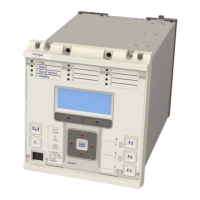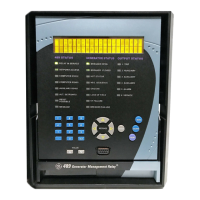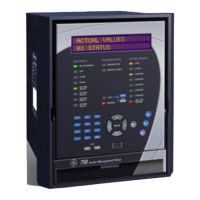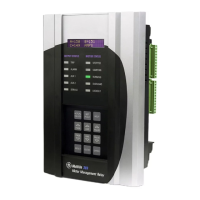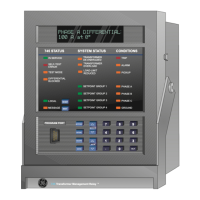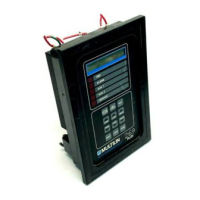3.2.3.1 EARTH FAULT REACTANCE LINES
Both forward and reverse reach reactance lines feature a fixed tilt. For the Impedance Reach line, the fixed tilt can
be set to reinforce underreaching or overreaching preferences for the zone. For the Reverse Impedance Reach line,
the fixed tilt is preset at -3º.
The tilting of the reactance lines can be set such that tilting will be affected by the choice of polarizing quantity. If
dynamic tilting is selected, the protection automatically chooses the best polarizing quantity from either the phase
current or negative sequence current. The choice depends on which line is being polarized and on the relationship
of measured currents I2 and Iph. When I2 is used as the polarizing quantity, the tilt can dynamically vary according
to the angle of I2. If Iph is used, the tilt remains fixed at the set angle.
Consider polarization of the reactance lines for the case of a phase-earth fault:
For a phase-earth fault:
V = Vph
and assuming that mutual compensation is not applied:
I = Iph + k
ZN
.IN.
To avoid overreaching or underreaching due to the voltage drop in the arc resistance, the top line of the
characteristic should be ideally tilted by an angle:
Ð
(I
fault
/ I)
So that the total angle of tilt should be:
Ð
(I
fault
/ I) + σ
where I
fault
is the fault current and σ is the fixed tilt of the reactance line (user setting for the Impedance Reach
line, fixed -3º preset for the Reverse Impedance Reach line.
If Z is the zone reach setting then the reactance line is formed by phase comparison between an operating signal
V – I Z (S1), and a polarizing quantity, I
POL
(S2).
I
fault
should be used to determine S2, but, because the Distance protection cannot measure the fault current
directly (due to the unknown infeed from the remote end), I
fault
cannot be used as the polarizing current. Instead,
the angle of I
fault
must be estimated. Two proven methods to estimate the angle of I
fault
are:
1. The angle of I
fault
can be assumed to be close to the angle of Iph
2. The angle of I
fault
can be assumed to be close to the angle of the negative sequence current I2.
In case 1, the angle of Iph can be used to polarize the Quadrilateral characteristic and so the tilt of the reactance
line is fixed.
In case 2 the angle of I2 can be used to polarize the Quadrilateral characteristic. In this case, the reactance line tilt
varies dynamically according to the angle of I2.
The reactance line follows the fault resistance impedance and tilts up or down, starting from the set initial tilt angle
(σ) to avoid underreaching or overreaching.
For both fixed and dynamic tilting the validity of current polarization is controlled by the following condition:
|
Ð
I2 -
Ð
Iph | < 45º
If this condition is not fulfilled, the assumptions that the angle of I
fault
is close to the angle of Iph or close to the
angle of I2 cannot be considered valid. Under such conditions the Quadrilateral characteristic could significantly
overreach or underreach. To avoid this, the distance protection automatically switches from Quadrilateral to Mho
characteristics to provide stable operation.
P446SV Chapter 7 - Distance Protection
P446SV-TM-EN-1 131
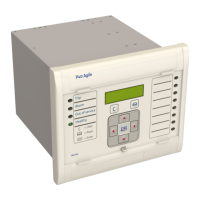
